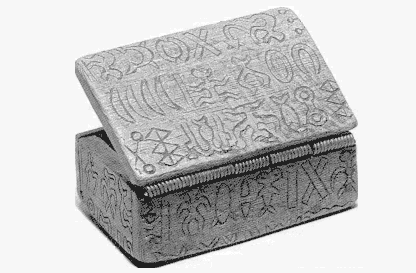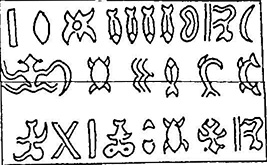
Rongorongo text Y
Encyclopedia

Rongorongo
Rongorongo is a system of glyphs discovered in the 19th century on Easter Island that appears to be writing or proto-writing. It cannot be read despite numerous attempts at decipherment. Although some calendrical and what might prove to be genealogical information has been identified, not even...
corpus, known as the Paris Snuff Box, is one of two dozen surviving rongorongo texts.
Other names
Y is the standard designation, continuing from BarthelThomas Barthel
Thomas Sylvester Barthel was a German ethnologist and epigrapher who is best known for cataloguing the undeciphered rongorongo script of Easter Island....
(1958). Fischer (1997) refers to it as RR5.
The nickname in French is La Tabatière.
Physical description
A single unfluted tablet or part of a tablet, cut into pieces and assembled into a snuff box, 71 × 46–47 × 26–28 mm. It is variously said to be made from foreign driftwood or Pacific rosewood. The glyphs that remain, though crudely carved with a steel blade, are in excellent condition, except in the center of the bottom piece where they have been worn down. There are no glyphs on the inside, as the tablet was planed down to a thickness 4–5 mm before being cut into pieces (Fischer 1997:497).  |
|||
 |
 |
 |
 |
 |
|||
Provenance
Although the provenanceProvenance
Provenance, from the French provenir, "to come from", refers to the chronology of the ownership or location of an historical object. The term was originally mostly used for works of art, but is now used in similar senses in a wide range of fields, including science and computing...
for this object is not good, and being cut with a steel blade makes it suspect, both Métraux
Alfred Metraux
Alfred Métraux was a Swiss anthropologist and human rights leader.-Early life:Born in Lausanne, Switzerland, Metraux spent much of his childhood in Argentina where his father was a well known surgeon resident in Mendoza. His mother was a Georgian from Tbilisi...
and Barthel believed it to be undoubtedly genuine. One reason is that it contains the rare glyph 36 and the rare compounds 38 and 684, and so is an unlikely forgery, though Barthel found out about it too late to include it in his catalogue. It was sold to the Musée de I'Homme in December 1961 by one Henry Reichlen, who had acquired it from a French family who had owned it for several generations — eighty years, by their count.
The box was presumably made by a sailor who did not recognize the value of the tablet. Since snuffboxes were more popular in the early part of the nineteenth century than later, when cigarettes became popular, it would likely have been acquired earlier than most surviving rongorongo texts.
Contents
The snuffbox has the repeated 380.1 glyph found on half a dozen other tablets which suggests it contains a list.Text
The top has three lines of glyphs, the bottom 2½, the four sides 1½. There are about 90 glyphs in all, many cut in half. Except for the front and back, which share a line cut lengthwise, the original relationship of the sections is not known.Barthel
Barthel (1958) did not transcribe this text, though he later accepted it as authentic.
Fischer


